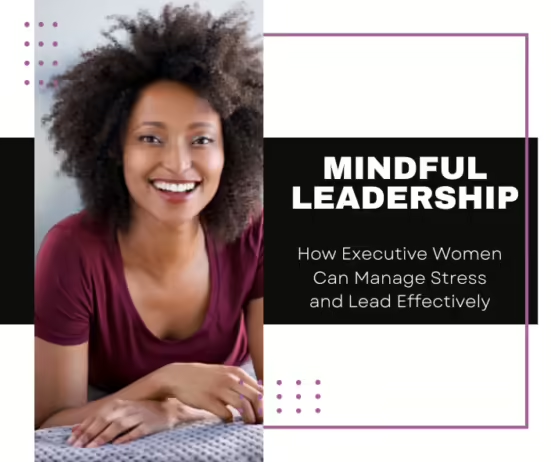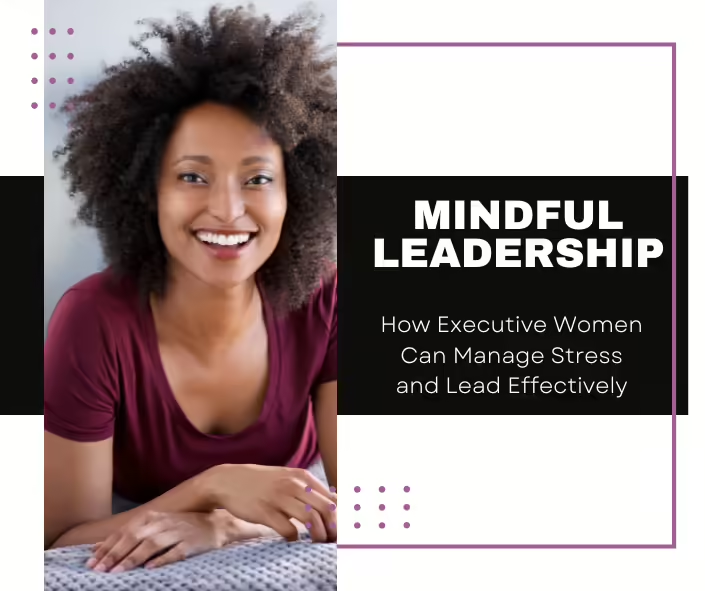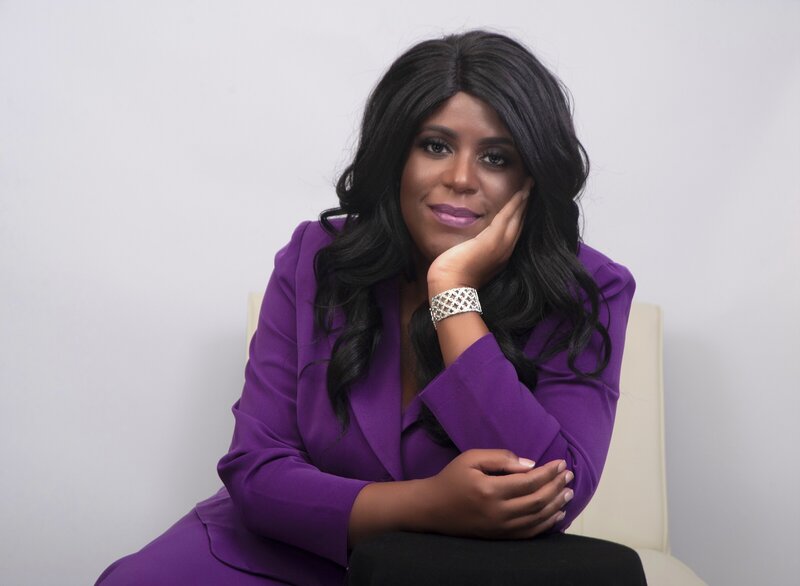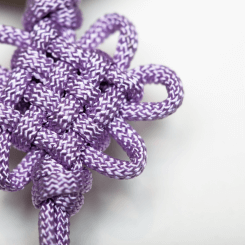November 25, 2024
In the final hours before a major presentation, Simone, a high-level executive, found herself in a familiar state of tension. As the clock ticked down, stress mounted, and her mind raced with the typical concerns: Will this be good enough? Can I balance everything on my plate? Yet, this time, she paused, took a few deep breaths, and practiced a short mindfulness technique. Instead of spiraling, she felt her focus return, and a renewed sense of calm settled in. For Simone, adopting mindful leadership practices had become her secret to managing stress and leading with clarity.


For many executive women like Simone, stress is a constant, often compounded by the unique pressures that come with high-stakes roles. Mindful leadership offers a powerful approach to not only managing stress but also enhancing effectiveness in the workplace. In this blog, we’ll explore how mindfulness can transform the leadership journey for executive women, helping them to lead with resilience, balance, and impact.
Defining Mindful Leadership
Mindful leadership is more than just a trend—it’s an empowering approach that helps executive women manage stress, cultivate resilience, and lead more effectively. At its core, mindful leadership emphasizes being fully present and engaged in the moment, helping leaders connect deeply with both their own goals and the needs of their teams. This presence allows leaders to handle high-stakes situations with clarity and calm, fostering a more stable and supportive work environment.
Central to mindful leadership are principles such as self-awareness, emotional regulation, and intentional decision-making. By understanding their own emotional responses and triggers, leaders gain control over their reactions, allowing them to respond thoughtfully rather than react impulsively. For executive women, this self-awareness can be a powerful tool in high-pressure environments, enhancing confidence and clarity while maintaining balance and reducing stress.
Incorporating mindful practices like deep listening and compassion also strengthens relationships within the team, creating a workplace culture that values well-being as much as productivity. When executive women lead with mindfulness, they inspire trust and loyalty, setting the stage for both personal and team success. Yet, to fully appreciate the benefits of mindful leadership, it’s essential to understand the unique stressors that executive women encounter daily.
Understanding the Stressors Unique to Executive Women
Executive women face a range of stressors that are often intensified by the demands of high-stakes roles. From consistently delivering results to navigating complex relationships, these challenges require resilience and a strong sense of self. For Black women in executive positions, additional layers of stress, such as the pressure to represent and the lack of visible role models, make mindful leadership an even more valuable tool for maintaining balance and focus.
Among the most common stressors are the expectations to balance work and personal life, meet high-performance standards, and continuously prove oneself. For many executive women, the relentless pace can lead to burnout, decision fatigue, and a constant feeling of “never enough.” By practicing mindful leadership, these leaders can counteract the effects of stress and prevent it from eroding their confidence and effectiveness.
The long-term impact of chronic stress can be profound, affecting not only an individual’s physical and mental health but also their leadership quality. Without effective stress management techniques, executive women may experience diminished job satisfaction, strained relationships, burnout, and even career setbacks. Mindful leadership offers a pathway to resilience, empowering leaders to manage these unique pressures and lead in a way that supports both personal well-being and professional success. With this in mind, let’s explore how mindful leadership can reduce stress while enhancing leadership effectiveness.
How Mindful Leadership Reduces Stress and Enhances Effectiveness
Mindful leadership equips executive women with powerful tools to reduce stress and enhance their effectiveness. By incorporating practices like deep breathing and focused attention, leaders can manage high-pressure moments with greater clarity and calm. This stress reduction not only helps them remain composed but also allows them to lead their teams more effectively, fostering an environment where everyone can thrive. For executive women, these practices offer a way to reset during demanding situations, creating space for clear-headed decision-making and balanced responses.
Another significant benefit of mindful leadership is its impact on decision-making. When leaders approach decisions mindfully, they can filter out distractions, focus on relevant information, and avoid impulsive choices. This approach leads to more strategic, thoughtful decision-making, allowing executive women to navigate complex challenges with greater insight and precision. In high-stakes settings, this focused decision-making enhances leadership quality and drives better outcomes for their teams and organizations.
Mindfulness also fosters empathy and improved communication, essential qualities for effective leadership. Leaders who actively listen and respond with compassion can create a supportive atmosphere that encourages trust and collaboration. By leading with empathy, executive women inspire loyalty and strengthen their team dynamics, building a resilient and motivated workforce. To begin reaping these benefits, leaders can adopt practical techniques to integrate mindfulness into their everyday routines.
Practical Mindful Leadership Techniques for Managing Stress
Integrating mindful leadership techniques into a busy executive routine doesn’t have to be overwhelming. Simple practices like mindful breathing exercises can be powerful tools to reduce stress quickly and effectively. One technique involves taking slow, deep breaths, focusing on each inhale and exhale. This brief moment of mindfulness can instantly shift a leader’s mindset from stress to calm, providing the focus needed to tackle pressing challenges with clarity.
Another helpful approach is setting aside time for a short daily mindfulness meditation. Even five to ten minutes each day can build resilience, improve emotional regulation, and create a grounded start to a busy workday. For executive women, this daily habit becomes a cornerstone of mindful leadership, helping them approach each day with balance and purpose, no matter what challenges arise.
In addition to personal mindfulness practices, leaders can bring mindfulness into team interactions through regular check-ins and active listening. By fostering open communication and modeling mindful behavior, executive women can create a supportive, high-performing team environment. These techniques are a strong foundation for mindful leadership, paving the way for greater resilience and connection. To illustrate these strategies in action, let’s look at real-life examples of mindful leadership in executive settings.
Real-Life Examples and Case Studies
Understanding mindful leadership in practice can make it easier for executive women to envision these techniques in their own lives. Take, for example, a case study of a senior leader who faced intense pressure during a company restructuring. By incorporating mindful breathing and short meditation breaks into her day, she maintained her composure, made strategic decisions, and supported her team through the uncertainty. Her commitment to mindfulness helped her navigate stress without compromising her leadership quality or team morale.
Another powerful example is an executive who regularly practices self-reflection to assess her emotional state and leadership choices. Before each team meeting, she takes a few moments to center herself and set a clear intention, such as promoting openness or cultivating empathy. This mindful preparation not only strengthens her confidence but also creates an atmosphere where her team feels valued and heard.
Additionally, many respected leaders have publicly shared how mindfulness has transformed their approach to leadership. From improved decision-making to better stress management, these stories show that mindful leadership isn’t just beneficial—it’s achievable and sustainable. By learning from these examples, executive women can gain the inspiration to start or deepen their own mindful leadership journey. But mindful leadership isn’t without challenges, and understanding these obstacles can help leaders stay committed to their practice.
Challenges and Misconceptions About Mindful Leadership
While mindful leadership is highly effective, it comes with its own set of challenges and misconceptions, particularly for executive women navigating demanding environments. One common misconception is that mindfulness is a “soft” approach, unsuitable for high-powered roles. However, this perception misses the true strength of mindfulness in leadership, which combines resilience, focus, and emotional intelligence. Far from being a weakness, mindfulness empowers leaders to handle complexity with a steady mind and clear vision.
Another challenge executive women may face is finding time to integrate mindfulness into their already busy schedules. Many leaders worry that practicing mindfulness will add another item to their to-do list rather than simplifying their approach. In reality, mindful leadership techniques can be as simple as taking a few deep breaths or pausing for a moment of self-awareness before responding to a challenging situation. By incorporating these small practices, leaders can make mindfulness a seamless part of their daily routine without overwhelming themselves.
Lastly, systemic barriers, such as limited support for wellness initiatives in certain corporate cultures, can hinder mindfulness efforts. It’s essential for leaders to recognize these barriers and find ways to cultivate resilience and mindfulness even in less supportive environments. By addressing these challenges with a strategic mindset, executive women can continue their journey in mindful leadership, setting the stage for a sustainable practice. Now, let’s look at how to begin a mindful leadership routine, even with a packed schedule.


How to Begin a Mindful Leadership Practice
Starting a mindful leadership practice doesn’t require a complete overhaul of your routine; in fact, it’s often most effective when introduced gradually. Begin with small, manageable practices, like setting aside just five minutes each morning for focused breathing or a quick meditation. These short, consistent practices can help executive women ease into mindfulness, building a foundation for greater resilience and stress management. Over time, these moments of calm become essential parts of the day, providing a steady anchor amidst high-stakes responsibilities.
Leveraging resources like mindfulness apps, podcasts, or even brief courses can also support the transition into mindful leadership. Many tools are specifically designed for busy professionals, making it easy to find short, effective practices that fit seamlessly into a demanding schedule. For example, apps like Headspace or Calm offer brief guided meditations that leaders can do on a lunch break or during a quiet moment in the day. With these resources, executive women can explore a variety of practices to discover what resonates most with their unique needs.
Creating accountability, whether through a partner, a coach, or a small group of like-minded professionals, can make it easier to maintain a mindful leadership practice over the long term. By having a support system, leaders can stay motivated and encouraged to prioritize mindfulness, even during particularly busy periods. With these steps in place, mindful leadership can become a sustainable, transformative part of an executive’s toolkit. To conclude, let’s recap the core benefits of mindful leadership and how it empowers executive women to lead with both strength and balance.
Final Thoughts
Embracing mindful leadership offers executive women a pathway to reduce stress, enhance decision-making, and foster stronger, more empathetic connections with their teams. By integrating simple, consistent mindfulness practices into their routines, leaders can navigate challenges with greater resilience, purpose, and clarity. Mindful leadership not only improves personal well-being but also creates a positive ripple effect throughout the workplace, leading to a more engaged and productive team.
For executive women seeking to refine their leadership skills and manage stress more effectively, adopting mindful practices is a powerful step. Ready to deepen your journey in mindful leadership? Download a copy of my Mindful Leadership: Practices for Women Executives ebook to explore practical strategies, exercises, and insights designed to help you lead with balance, confidence, and impact.
Frequently Asked Questions (FAQs) About Mindfulness
1. What is mindful leadership, and how does it differ from traditional leadership?
- Mindful leadership is an approach that emphasizes presence, self-awareness, and empathy in leading others. Unlike traditional leadership, which often focuses solely on results, mindful leadership integrates emotional intelligence and self-reflection, empowering leaders to connect deeply with their teams and manage stress effectively. This approach fosters a balanced, people-centered leadership style that enhances both productivity and workplace morale.
2. How can mindfulness help reduce stress for executive women?
- Mindfulness helps reduce stress by encouraging leaders to stay grounded and fully present in the moment. Techniques like mindful breathing, meditation, and self-reflection calm the mind, reduce emotional reactivity, and improve focus. These practices allow executive women to navigate high-stakes situations with greater resilience and clarity, reducing the effects of chronic stress.
3. What are some quick mindfulness practices I can incorporate into my daily routine?
- Simple practices include mindful breathing exercises, taking five minutes for focused meditation, or doing a brief body scan to release tension. These techniques can be done throughout the day, such as before meetings or during a lunch break. Small but consistent practices build a foundation of mindfulness, making it easier to manage stress in real time.
4. Can mindfulness improve my decision-making skills as a leader?
- Absolutely. Mindful leadership enhances decision-making by helping leaders stay focused, reduce impulsive reactions, and consider situations thoughtfully. Through mindfulness, leaders develop the ability to assess information objectively and respond with clarity, which is crucial in high-stakes executive roles. Mindful decision-making fosters better strategic thinking and more intentional outcomes.
5. What are the main challenges in adopting mindful leadership, and how can I overcome them?
- Common challenges include misconceptions that mindfulness is “too soft” for executives, time constraints, and a lack of workplace support. To overcome these, start with short, manageable mindfulness practices that don’t interfere with your routine. Joining a mindfulness group or finding an accountability partner can also help reinforce the habit, keeping mindfulness a priority even during busy periods.
6. How can mindful leadership impact my relationships with my team?
- Mindful leadership promotes empathy, active listening, and a greater understanding of team members’ perspectives. By modeling mindfulness, leaders create a more supportive and inclusive team environment where employees feel valued and understood. This fosters stronger team dynamics, trust, and loyalty, ultimately leading to higher team morale and productivity.
7. Where can I find resources to help me develop mindful leadership skills?
- There are many resources available, including mindfulness apps like Calm and Headspace, podcasts, and mindfulness-focused books. For a deeper dive, download my Mindful Leadership ebook, which offers practical strategies and exercises tailored for executive women. It’s a comprehensive resource designed to help you cultivate mindful practices and elevate your leadership approach.


I’m an ICF Professional Certified Coach (PCC) and executive coach for Twanna Carter Professional & Personal Coaching, LLC. I flubbed my first career transition from the military so badly, it took me the next 10+ years to build my confidence and recover. I know what it feels like to struggle with imposter syndrome and uncertainty about my leadership skills in the workplace. It’s why I am dedicated to empowering Black women. Helping them navigate career challenges and uncertainty by providing them with the tools and strategies they need to be successful. Schedule a V.I.P. Roadmap session today.
If you enjoyed this blog, please share it. If you’re feeling generous buy me a coffee.
Read my latest blogs…
- The Fear-Based Leadership Cycle Secretly Running Your Life. And How to Break ItFear is a powerful emotion. It can protect you, warn you, and heighten your awareness. But when fear begins to lead you, especially in leadership… Read more: The Fear-Based Leadership Cycle Secretly Running Your Life. And How to Break It
- Redefining Success. How Black Women Executives Are Leading a New Era of Authentic LeadershipThe New Leadership Trend. Redefining Success Across boardrooms, Zoom calls, and LinkedIn feeds, a powerful shift is underway. Women of color, especially Black women executives,… Read more: Redefining Success. How Black Women Executives Are Leading a New Era of Authentic Leadership
- How to Quiet the Inner Critic and Stop Second-Guessing Yourself in High-Stakes RoomsUnderstanding the Inner Critic Your inner critic is that persistent internal voice that judges, doubts, and second-guesses you. Ooften at the worst possible moments. For… Read more: How to Quiet the Inner Critic and Stop Second-Guessing Yourself in High-Stakes Rooms
- The Survival Blueprint. What To Do Immediately When You Realize You’re Being Managed OutUnderstanding What “Being Managed Out” Really Means. And Why Immediate Help Matters The first time I realized I was being managed out, I didn’t label… Read more: The Survival Blueprint. What To Do Immediately When You Realize You’re Being Managed Out
- 10 Powerful Reasons Why Black Women Entrepreneurs Are Leading the Rise of EntrepreneurshipWhy Black Women Entrepreneurs Are Leading the Rise of Entrepreneurship Entrepreneurship has always symbolized courage, innovation, and self-determination. And no one represents that spirit more… Read more: 10 Powerful Reasons Why Black Women Entrepreneurs Are Leading the Rise of Entrepreneurship
- The Leadership Myth That Hurts High-Achieving Black Women. Why Slowing Down Doesn’t Make You Weak.Slowing Down Doesn’t Make You Weak Leadership isn’t just about speed, stamina, or sacrifice. It’s about authenticity, vision, and sustainable strength. Yet, a damaging leadership… Read more: The Leadership Myth That Hurts High-Achieving Black Women. Why Slowing Down Doesn’t Make You Weak.
- Quiet Cracking -7 Signs You’re Not ‘Fine’. You’re Burning Out in SilenceUnderstanding Quiet Cracking Quiet cracking is a modern mental-health phenomenon that describes the slow, invisible unraveling of your emotional resilience. TalentLMS reports that over 50%… Read more: Quiet Cracking -7 Signs You’re Not ‘Fine’. You’re Burning Out in Silence
- Top 10 Powerful Reasons for Career Change. Why It’s Never Too Late to Start FreshUnderstanding the Need for a Career Change Changing careers is no longer rare. It’s the new normal. Today, professionals across industries are re-evaluating what truly… Read more: Top 10 Powerful Reasons for Career Change. Why It’s Never Too Late to Start Fresh
- The Hidden Cost of Being the Strong One at WorkThe Unseen Weight of Being the Strong One at Work At every office, there’s usually one person everyone leans on, the dependable one, the calm… Read more: The Hidden Cost of Being the Strong One at Work
- Here’s How to Break the Cycle of Second-Guessing and DoubtUnderstanding the Cycle of Second-Guessing Leadership self-doubt among Black women doesn’t appear out of thin air. It forms slowly, shaped by years of subtle messages,… Read more: Here’s How to Break the Cycle of Second-Guessing and Doubt
- How Executive Black Women Get Trapped in Survival Mode (And Why It’s Not Your Fault)Understanding High-Achieving Women Trapped in Survival Mode Survival mode is a state of constant alertness where your mind and body operate as if you’re in… Read more: How Executive Black Women Get Trapped in Survival Mode (And Why It’s Not Your Fault)
- Executive Coaching for Black Women – How to Lead with Authority, Confidence, and Emotional Well-BeingExecutive coaching for Black women is more than a leadership perk. It’s a necessary pathway to healing, empowerment, and sustainable success in spaces where Black… Read more: Executive Coaching for Black Women – How to Lead with Authority, Confidence, and Emotional Well-Being
Curated Reading List Just for You
- Corporate Blues, The Untold Stories of Women in Toxic Workplaces, presented by Dr. Carey Yazeed, featuring Dr. Twanna Carter
- Job Offers 101 – Everything You’ve Always Wanted to Know by Dr. Twanna Carter
- Melaninated Magic: 180 Affirmations to Nurture Your Soul and Unleash Your Black Girl Joy by Dr. Twanna Carter
- Unbreak My Soul: How Black Women Can Begin To Heal From Workplace Trauma, by Carey Yazeed, PhD
- The Next Level: A 30-Day Career Growth Planner for Black Women by Dr. Twanna Carter
- 33 Tools to Remake Your Career by Paul Gabriel Dionne
- I’m Not Yelling: A Black Woman’s Guide to Navigating the Workplace (Successful Black Business Women), by Elizabeth Leiba.
- Crucial Conversations: Tools for Talking When Stakes Are High by Kerry Patterson, Joseph Grenny, Ron McMillan, and Al Switzler.
- Influence: The Psychology of Persuasion by Robert B. Cialdini.
- How to Win Friends and Influence People by Dale Carnegie.
- Overworked and Undervalued: Black Women and Success in America by Rosalyn D. Davis, Sharon L. Bowman, et. al.
- Power Negotiation – Getting to the Yes: Strategies to Get What You Want, When You Want It by Patrick Kennedy
- Set Free to Live Free: Breaking Through the 7 Lies Women Tell Themselves by Saundra Dalton-Smith, MD






















+ show Comments
- Hide Comments
add a comment